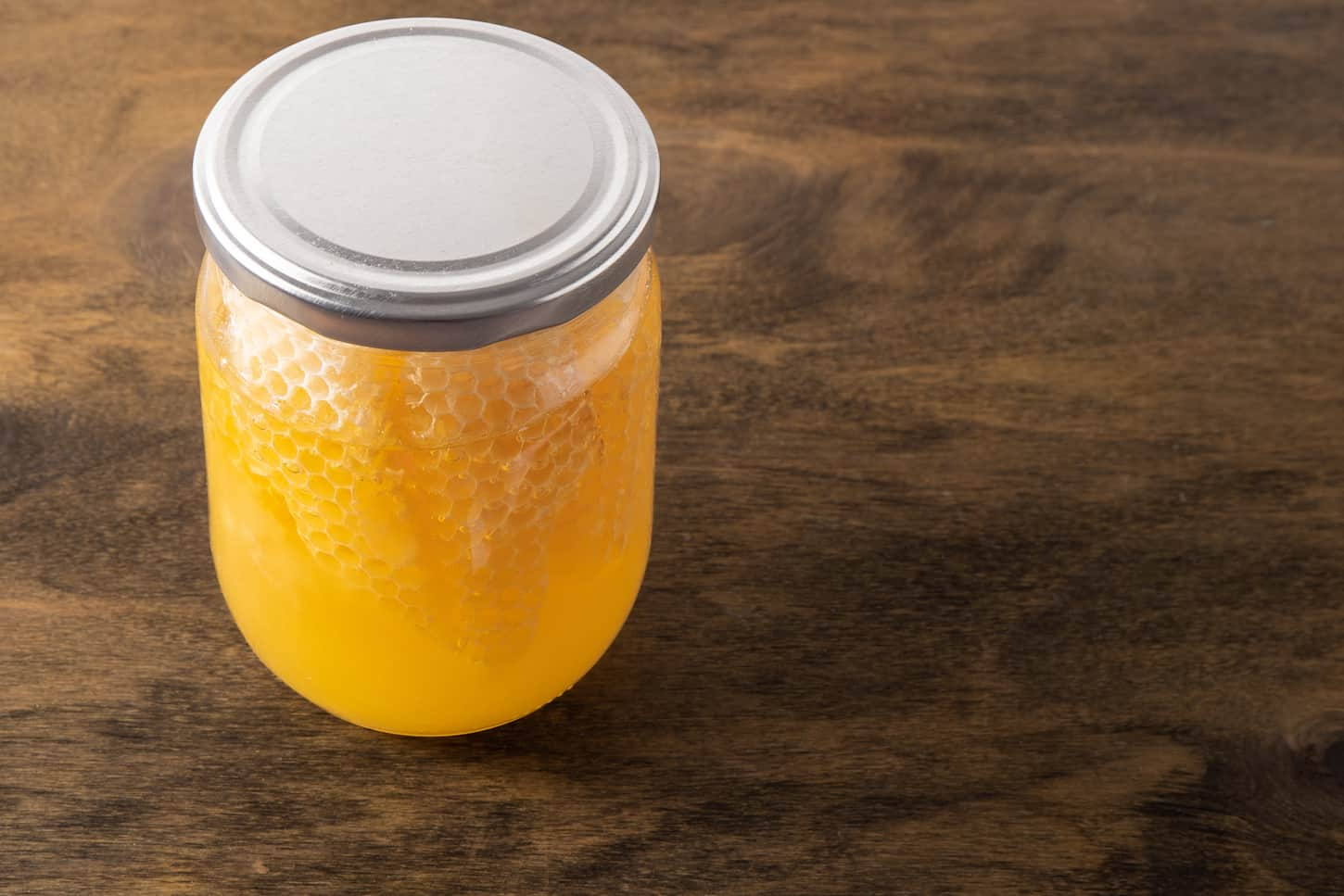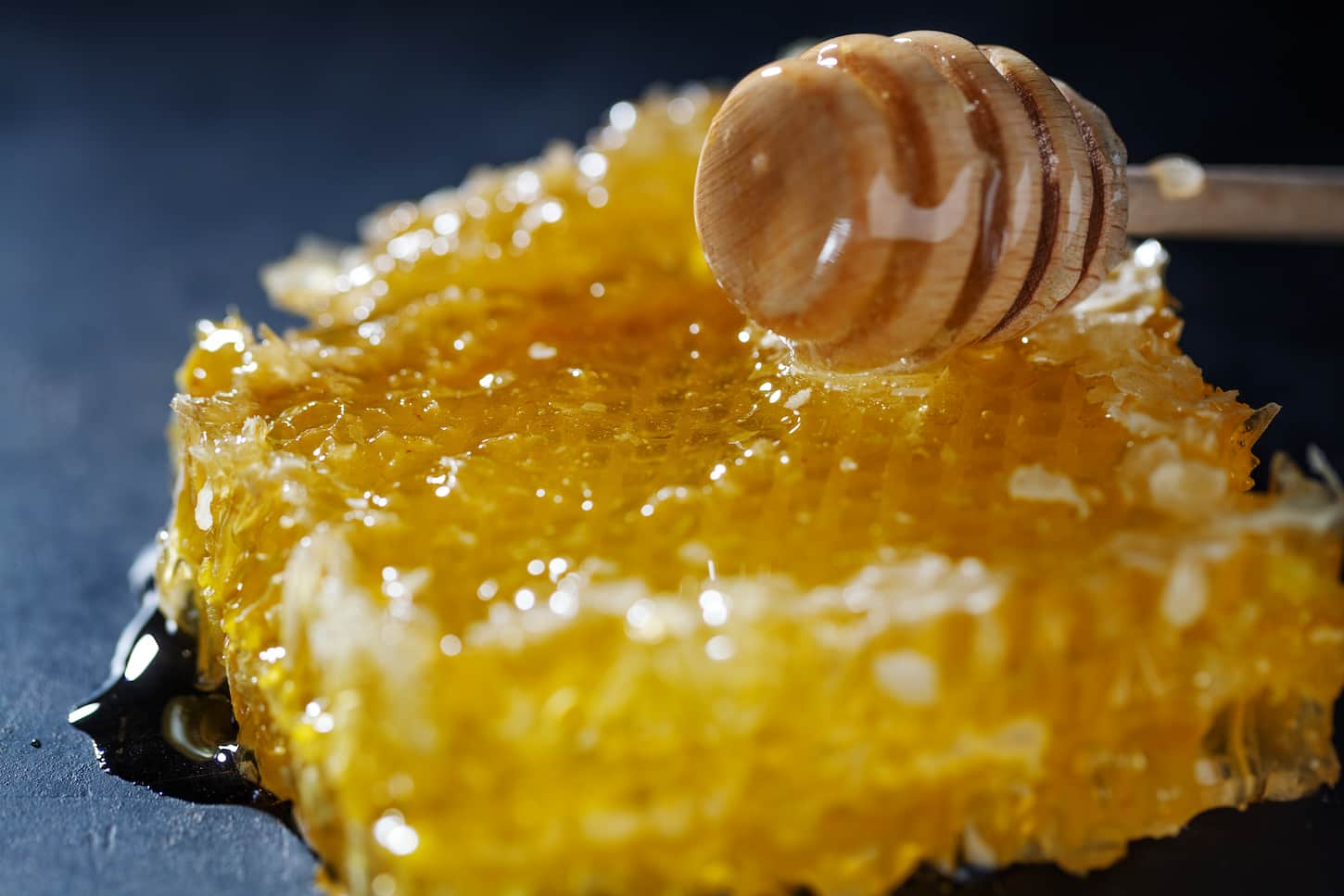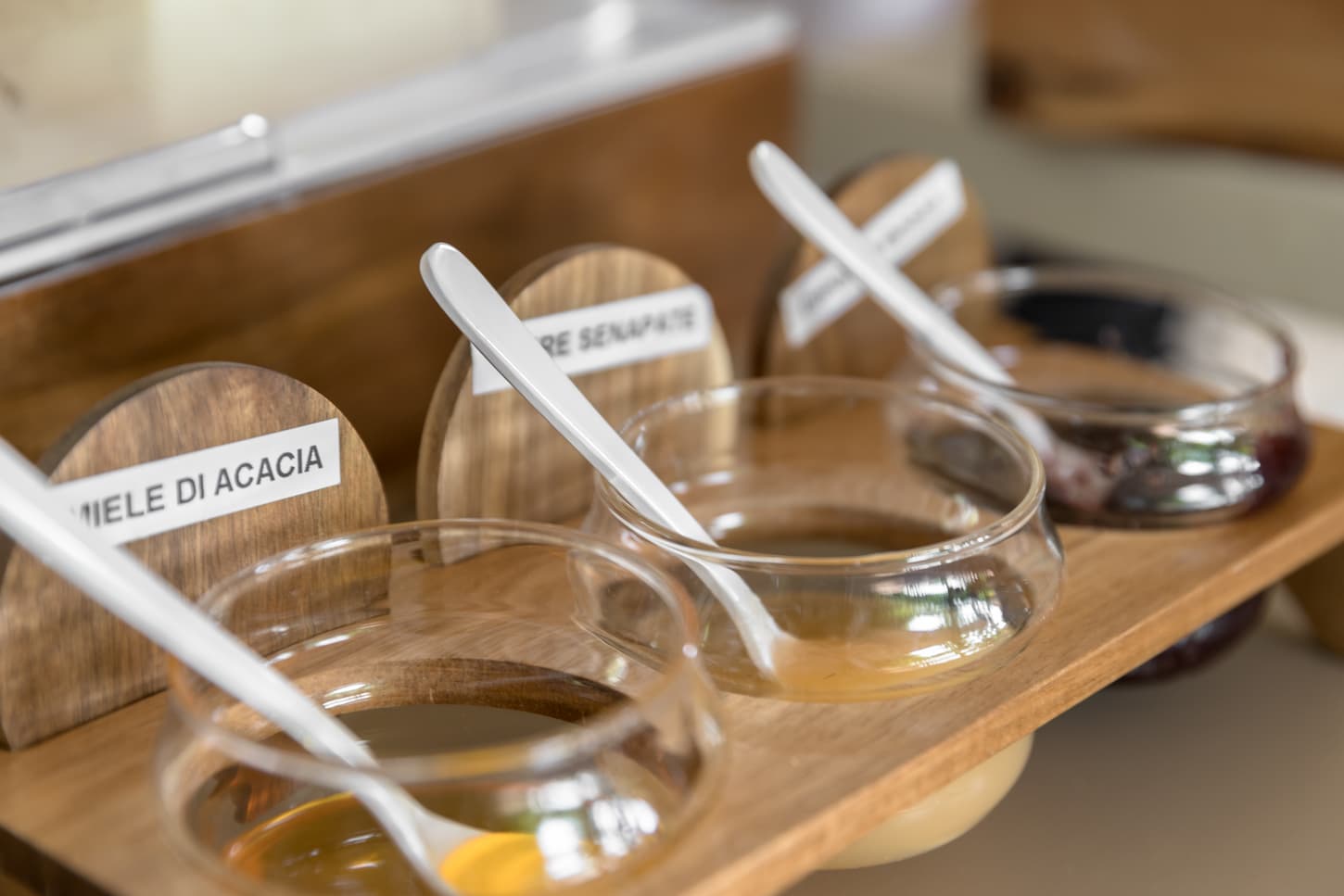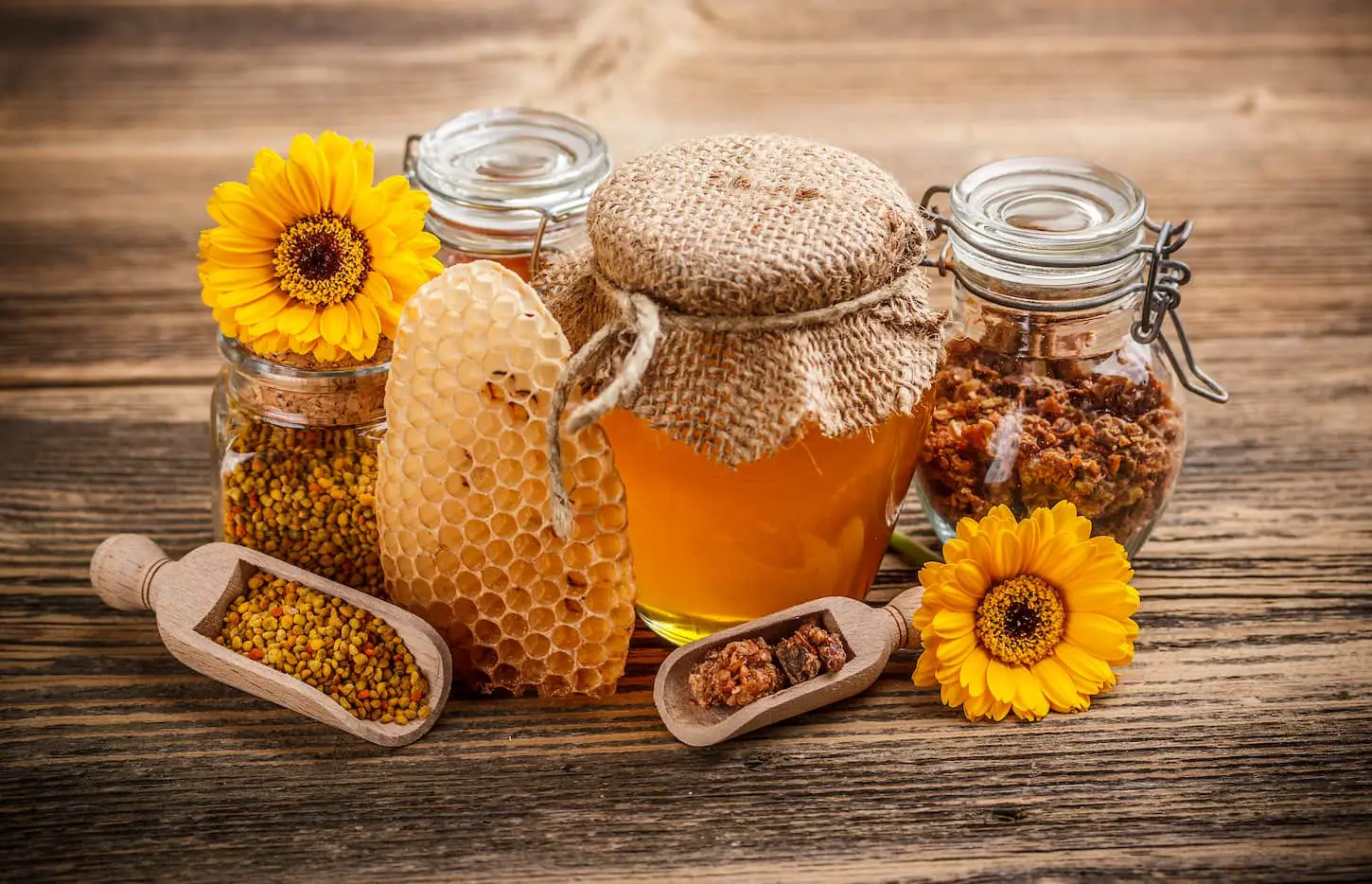Whether raw or pasteurized, honey is always good in our cupboard. It’s a suitable sugar replacement that packs lots of benefits. Once honey becomes part of our regular diet, we’ll find out that having a steady supply is important.
To store honey properly for either short or long-term use, first, make sure to have a well-sealed container. Next, look for a place with the least amount of sun to place the sealed honey. Avoid warm places or areas around the house that catch direct sunlight.
Honey has a long shelf life. Store-bought honey lasts about two years. But the truth is, it can last much longer if stored correctly. Read on for more tips on keeping honey fresh the right way.

How to Store Fresh or Raw Honey
Some people raise their bees for honey and have lots of it to store. The best way to store it is to transfer the honey to a glass jar that can be sealed. Then, keep the honey in a dark location at room temperature.
Honey can also be stored using food-grade plastic containers if there aren’t any sealable glass jars. However, avoid metal containers because the honey will oxidize in them.
It’s also important not to put raw honey in the refrigerator. This will cause some parts to crystallize, making it hard to spread. However, crystallization does not mean the honey is bad. We can still use it.
Some people even make something called creamed honey with honey crystals. This gets rid of the gritty, crystallized honey. However, crystallized honey can sometimes form even in a cupboard when the temperature drops too low, so don’t be surprised.
Another alternative is re-liquefying it by heating it. Put the jar in a container of hot water and stir the contents. This allows the crystals to “melt” and join the other liquid.
It also makes it easy to control the heat by putting it directly into the microwave, though using the microwave to heat honey directly can overheat it and cause flavor changes over time. If you want to use the microwave, it’s always safer (and better) to heat water in the microwave and then put the container of honey (preferably only holding the amount of honey you’ll be using) into the warm water.
Storing Store-Bought Honey Tips
When buying honey from a store, it usually comes in a glass jar or a plastic food-grade container. Keep it in the container it was received in, then look for a cool, dark place in the cupboard to store it.
If buying the honey sold in plastic containers, transfer the honey to a glass jar with a tightly sealable lid. However, if confident the honey will be used within two years, there’s no harm in keeping it in a plastic container.
Most store-bought honey has a best-before date printed on the container. Usually, manufacturers will tell consumers the product expires within two years. Honey can last longer and usually won’t spoil unless it is not stored correctly.
How to Store Honey After Opening
Close and tighten the lid and place it in a cool, dark cupboard. Ensure the area it’s stored in is at room temperature – otherwise, the honey might crystallize. If the honey is in a different type of container, transfer it to a glass jar with a tight lid.
The container honey is bought in is good enough since it’s already food-grade. However, if it’s fresh honey or we don’t like its container, we recommend transferring the honey to a glass jar with a tight lid. Don’t transfer the honey to a metal container.
How to Store Honey Long-Term
A sure way to store honey is to transfer it to a glass jar with a tight lid. Next, keep the honey in an area that is room temperature and out of the sun as much as possible. Finally, after using the honey, return it to its proper storage to last longer.
The most important reminder is to put the honey container back into storage after every time it’s used. Many people tend to forget and leave the jar on the table, which usually exposes it to sunlight.
Some even accidentally put it in the fridge after using it out of habit with other foods.

How Long Does Honey Last?
Honey has no expiration date – it lasts forever if it is stored properly. Honey that crystallized is still edible and safe, though the crystals may affect the texture. Heating the crystalized honey slightly can remove the crystals sufficiently to restore the original texture.
When it comes to food, people worry about the expiration date. This is a valid concern that should be considered when preserving food. Usually, if food is nearing its expiration date or going bad, it loses some of its health benefits. So, what about honey?
Does honey expire?
The truth is honey doesn’t expire. This sweet sugar alternative is good forever if stored properly. According to the National Honey Board, if we keep our honey in an airtight container, the contents will remain edible indefinitely. Honey generally only goes bad if stored improperly or contaminated.
If it’s been a while since you last opened a jar, the honey might have either crystallized or gotten darker in color. The new form of dark discoloration is nothing to worry about. There’s a way to turn it back into the usual syrupy texture.
As for the new dark color, it’s entirely safe for us to eat the honey if it’s been stored properly.
Does honey go bad?
While honey doesn’t expire, it can crystalize over time if it isn’t stored correctly. Mild crystallization doesn’t mean it’s gone bad, though many people won’t eat it after it’s too crystalized. Honey can also be accidentally contaminated with another product while using a spoon to scoop out the contents of the jar.
To ensure that honey will last a long time, we recommend safely storing it every time. Additionally, please use clean utensils to scoop out the contents.
It’s also good to heat the honey if it has crystallized. This could also mean transferring it to different containers in a dark storage area if crystals form in the jars.
How to Store Honey So It Doesn’t Crystalize
To avoid crystallization in honey, store the honey in an area that is either room temperature or slightly warmer. Avoid keeping the honey in cold places, or in the fridge because it will crystallize. However, there is always a way to revert the honey to its original state via mild warming.
What to do with crystallized honey
If honey crystallizes, there is no reason to panic. It is still edible – it can be heated until the crystals disappear. Some people prefer their honey to be like this instead of its normal state. However, if we choose it as a syrup, we can continually heat it to break it down.
Be careful when heating honey – overheating it may cause a change in flavor. To retain the taste, keep the honey away from the burner.
Instead, use a double-boiler system off the burner. Heat water, remove the pot, and turn off the burner. Then get the honey container and put it in warm water, and stir the honey until the crystals are broken down.
Here’s a helpful tip to help the honey last longer if there is not a dark, cool storage area that prevents crystallization. Heat and liquefy only the amount needed each time.
Repeatedly heating the same batch of honey will cause it to change flavor over time.
Remember not to microwave or boil honey. Never heat it in a plastic container. This might affect the taste and shelf-life; it can also be dangerous.

FAQs on Storing Honey
People have been wondering if there are other ways to store honey other than what we’ve mentioned above. They have been looking at options for storing it alternatively. Let’s look at these options one by one.
Don’t see your question answered? I’d love to fix that! Use my contact page to send me your question. I’ll answer you directly and get this article updated.
Can you dehydrate honey?
Dehydrating honey can ensure its indefinite shelf life. This process is good because less precision is required, and it’s easily stored since the moisture is already taken out. But, unfortunately, this also rules out the possibility of growing any yeast.
To dehydrate the honey, get a proper food dehydrator. First, spread the honey on parchment paper. Then, place it in the dehydrator to start the process. According to most dehydrating and food storage books I’ve read, setting the machine to 120 degrees is recommended.
Once fully hardened, take it out right away, then leave it in a cool, dry place. There’s a tendency for honey to burn if kept in the dehydrator. Remember to avoid storing dehydrated honey in humid areas.
Once the honey is dehydrated correctly, it can be broken up into smaller pieces and put into any type of container if it’s sealed and stored in a dry area. Use this honey as a spice or something to top baked goods.
Is it okay to keep honey in the fridge?
It’s not a good idea to keep honey in the fridge. If it is kept in the refrigerator, it will only increase the crystallization of the product. So instead of its normal texture, it will be thick and doughy. Plus, the extra moisture might even alter the flavor.
While the honey is still edible and can be reheated, the shelf-life is now in question. In addition, the extra moisture might eventually alter the honey’s taste and might even cause bacteria to grow if left outside the refrigerator afterward.
Can you freeze honey?
Honey can be frozen, but it needs to be used immediately once melted. Instead of buying large containers, get several small food-grade containers and only take the amount required each time it is heated. Honey should only be stored this way as a last resort.
Please don’t do any social media challenges related to honey. For example, there’s a recent TikTok trend where you freeze honey and consume it as a treat, but this can cause health problems such as stomach issues. Keep honey away from the refrigerator unless it is the only storing option.
The frozen honey challenge was a TikTok trend that included users freezing honey in a water bottle and consuming it afterward. However, several users who have tried this challenge ended up with diarrhea or other stomach issues after consuming the frozen honey.
In addition, experts say that this can cause a possible trip to the dentist.
Can you freeze-dry honey?
Honey doesn’t freeze-dry well, so it’s best not to explore this option. Honey is a highly saturated solution that has only 17.1 grams of water. As a result, it becomes glassy at any temperature between -44 to -66 Fahrenheit. Even Harvest Right’s blog recommends not freeze-drying the product.
We tried freeze-drying a small bit of it. It really didn’t work well. Save yourself the trouble, especially since honey doesn’t go bad unless you store it improperly or contaminate it.
If you want to solidify honey for long-term storage, don’t freeze-dry it. Dehydrate it instead.
Can you can honey?
Honey does not need to be canned for storage. Metal cans might even cause honey to go bad faster (due to metallic oxidation) than putting it in a glass mason jar. Honey is an acid that usually has a bad reaction with metal for extended periods, such as storage.
Honey will eventually oxidize and develop a different odor and flavor if kept in a metal can. You also run the risk of corrosion and even overheating the honey.
If planning on doing this, it’s better to keep the honey in the food-grade container it was bought in, or in mason jars.

What Other Products Can I Turn My Honey Into?
Honey is great for making lots of products such as soap, different types of sweets, scented candles, and many other edible treats.
If there is an ample supply of honey and we want to get into other types of business, there are many options besides selling it. Here are a few ideas for products made with honey.
Can you make honey into soap?
Honey is an excellent additive for making soap. Its sugar content helps increase the amount of lather and even acts as a humectant.
Honey has been used for several beauty products, even in the past. So, why not incorporate past ingredients into current ones?
We don’t even have to add a lot of it to make a good soap bar. Some people have claimed that using just a tablespoon of honey per pound of soap is enough to get all the benefits.
Can you make honey into candy?
Another way of consuming honey is by turning it into candy. Instead of drinking it as a liquid, it can be made into hard candy treat. Some of those treats can be used as an antidote for a sore throat.
Storing the candy is easy. Just wrap the candies individually using baking paper, then store them in a Ziploc bag or another airtight container.
Make honey into scented candles
Some of the best-smelling candles are made with honey. Maximize the honey’s sweet and cozy aroma when using it as an ingredient for making scented candles. Scented candles are also a popular gift.
There’s something so comforting about the scent of warm honey and vanilla. When making honey-scented candles, usually another scent is thrown into the mix.
People have claimed that adding milk or vanilla mixes well with the naturally sweet scent of honey. The aromas are associated with comfort, coziness, and warmth. So, light one of these candles if you’re looking for scents to help you unwind.
Other edible treats
Honey can be used as an ingredient for various baked goods and even savory dishes. The sweetness it gives is something special and a sure way to get people to enjoy a new dish. Honey can be used instead of sugar in baked goods if you adjust the overall quantity of liquids in the recipe.
Honey is a popular flavor for most baked goods. Incorporate the honey into the mix for baking or use it to drizzle over them once completed. Both adults and kids will enjoy the different options available.
Honey can also be used as a glaze in savory dishes like fish and ribs. It can also be incorporated into dipping sauces and salad dressings to give the usual sourness a different kick of spice and sweetness.
Key Points and Next Steps
Honey really is an amazing food. I think it should be part of any food storage setup, especially if you’re a backyard homesteader.
If you aren’t keeping bees yet, I recommend you think about it. And to help get you started, read my article on why beekeepers wear white here – so that you’ll be that much more prepared to keep bees.
If you are keeping bees already, that’s fantastic. The fresh honey won’t freeze-dry well, but it can dehydrate amazingly. You can read more about the differences between freeze-drying and dehydrating in my article here: Freeze Dryer Vs. Dehydrator: What’s the Difference?

Resources
Learning from your own experience is essential, but learning from others is also intelligent. These are the sources used in this article and our research to be more informed as homesteaders.
- “Extracted Honey Grades and Standards | Agricultural Marketing Service.” USDA, www.ams.usda.gov/grades-standards/extracted-honey-grades-and-standards. Accessed 3 June 2022.
- “Food Data Central.” USDA Food Data Central, 19 Apr. 2019, fdc.nal.usda.gov/fdc-app.html#/food-details/169640/nutrients.
- Harvest Right. “What Kind of Food Can I Freeze Dry?” Harvest Rightâ„¢ | Home Freeze Dryers | Freeze Dried Food Storage, 15 Nov. 2019, harvestright.com/blog/2017/what-kind-of-food-can-i-freeze-dry.
- “Honey.Com.” National Honey Board, 19 May 2022, honey.com.
- “How to Dehydrate Honey | Livestrong.Com.” LIVESTRONG.COM, www.livestrong.com/article/556333-how-to-dehydrate-honey. Accessed 21 May 2022.
- Laura. “Easy Honey Vanilla Candle Recipe.” Our Oily House, 6 Dec. 2021, www.ouroilyhouse.com/honey-vanilla-candles.
- “National Honey Board | Agricultural Marketing Service.” USDA, www.ams.usda.gov/rules-regulations/research-promotion/honey. Accessed 3 June 2022.